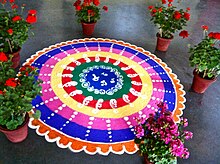
Back رانغولي Arabic আল্পনা Assamese रंगोली Bihari রঙ্গোলি Bengali/Bangla Rangoli Catalan Rangoli Spanish Rangoli Basque Rangoli French רנגולי HE रंगोली Hindi
This article needs additional citations for verification. (October 2010) |



Rangoli is an art form that originates from the Indian subcontinent, in which patterns are created on the floor or a tabletop using materials such as powdered limestone, red ochre, dry rice flour, coloured sand, quartz powder, flower petals, and coloured rocks. It is an everyday practice in many Hindu households; however, making it is mostly reserved for festivals and other important celebrations as it is time-consuming. Rangolis are usually made during Diwali or Tihar, Onam, Pongal, Ugadi and other Hindu festivals in the Indian subcontinent, and are most often made during Diwali. Designs are passed from one generation to the next, keeping both the art form and the tradition alive.[1]
Rangoli have different names based on the state and culture. Rangoli hold a significant role in the everyday life of a Hindu household especially historically when the flooring of houses were untiled. They are usually made outside the threshold of the main entrance, in the early mornings after cleaning the area. Traditionally, the postures needed to make a rangoli are a kind of exercise for women to straighten their spines. The rangoli represents the happiness, positivity and liveliness of a household, and is intended to welcome Lakshmi, the goddess of wealth and good luck. It is believed that a Hindu household without a clean entrance and rangoli is an abode of daridra (bad luck).
The purpose of rangoli is beyond decoration. Traditionally either powdered calcite and limestone or cereal powders are used for the basic design. The limestone is capable of preventing insects from entering the household, and the cereal powders attract insects and keep them from entering the household. Using cereal powders for rangoli is also believed as panch-mahabhoota Seva[clarification needed] because insects and other dust microbes are fed. Design depictions may vary as they reflect traditions, folklore, and practices that are unique to each area. Rangoli are traditionally made by girls or women, although men and boys create them as well. In a Hindu household, basic rangoli is an everyday practice. The usage of colours and vibrant designs are showcased during occasions such as festivals, auspicious observances, marriage celebrations and other similar milestones and gatherings.
Rangoli designs can be simple geometric shapes, depictions of deities, or flower and petal shapes appropriate to the given celebrations. They can also be made with elaborate designs crafted by numerous people. The geometric designs may also represent powerful religious symbols, placed in and around household yagna shrines. Historically, basic designs were drawn around the cooking areas for the purpose of discouraging insects and pathogens. Synthetic colours are a modern variation. Other materials include red brick powder and even flowers and petals, as in the case of flower rangoli.
Over time, imagination and innovative ideas in rangoli art have also been incorporated. Rangoli have been commercially developed in places such as five star hotels. Its traditional charm, artistry and importance continue today.
- ^ Macnabb Cambell, James (1884). Gazetteer of the Bombay Presidency: Dháwár. Government Central Press. p. 821.